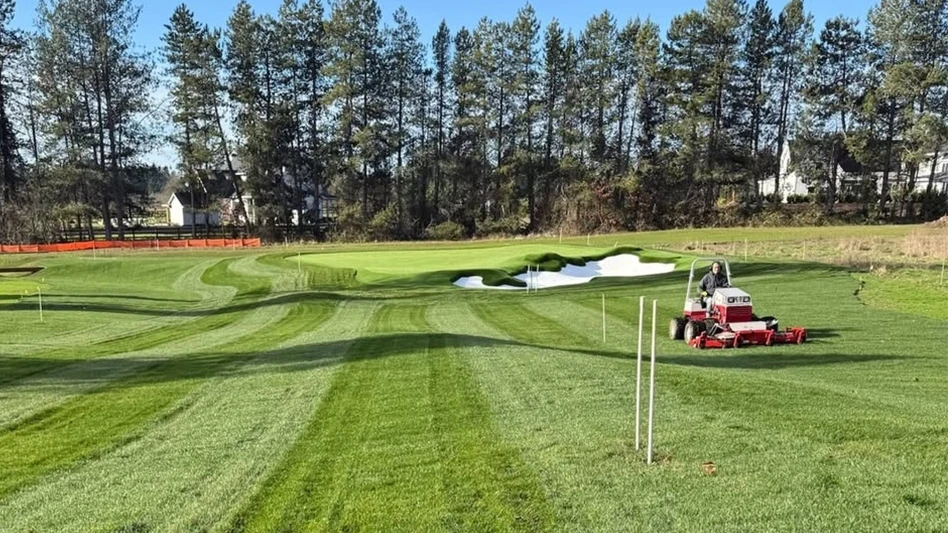Editor’s Note: A version of this article first ran in the Alabama Green Journal. It was updated by the authors and is reprinted with permission.
Herbicide resistant weeds are among the most troublesome issues facing the turfgrass industry. The loss of effective and economically viable herbicides results in lower quality turf and increases weed management budgets. Herbicide resistance is the inherited ability of a plant population to survive and reproduce following treatment with a normally lethal dose of herbicide. This is not a new issue. Simazine and atrazine resistant groundsel (Senecio vulgaris) was reported as early as 1970 (Ryan, 1970). Simazine resistant annual bluegrass (Poa annua) has plagued golf courses, sports fields, industrial turf, and sod producers in the southeastern United States for more than two decades. As of 2014, more than 420 unique cases of herbicide resistant weeds have been reported globally (Heap, 2014). That equates to 232 species having evolved resistance to 22 of 25 known herbicide sites of action and to 152 different herbicides. Table 1 lists herbicide resistant turfgrass weeds of the United States as of 2014.
Preventing and managing herbicide resistance is crucial to preserving key chemistries that turfgrass managers use to provide a playable and aesthetically pleasing turf surface. It is important to understand some basic terminology associated with herbicide resistance.

Mode-of-action (MOA)
Herbicides are active at one or more target site(s) within plants. Target sites are often enzymes that play a critical role in plant metabolism. The term site-of-action is used interchangeably with MOA; however, the terms have somewhat different connotations. The MOA is how a herbicide kills a plant. For instance, atrazine inhibits photosystem II, subsequently leading to a build-up of oxidative free radicals and a decrease in photosynthesis. Site-of-action is where the herbicide binds in order to kill a plant. Atrazine inhibits photosystem II by binding to a specific site-of-action, the Quinone B binding niche on the D1 protein.
Table 2 lists common turfgrass MOA’s and example trade names. The fundamental principle for managing herbicide resistance is this: repeatedly relying upon a single MOA selects for populations that are resistant. Herbicides do not cause a mutation; they merely select for populations that tolerate a dose of herbicide. Subsequently, those populations expand in number.

Preventing herbicide resistance requires rotating herbicide MOA’s in order to avoid the expansion of resistant populations. Classification systems have been developed to help herbicide applicators alternate MOA’s. The most common are those developed by the Weed Science Society of America (WSSA) and the Herbicide Resistance Action Committee (HRAC).
The WSSA system assigns each herbicide a number based upon the MOA. The HRAC system assigns a letter based upon an alphabetized list of herbicide MOA’s, hence inhibition of acetyl CoA carboxylase (ACCase) is assigned the HRAC grouping of A. HRAC further amends herbicide groupings with a sub-script numbering system that indicates different binding behavior. In the case of photosystem II inhibiting herbicides, subclasses C1, C2, and C3 indicate different behavior with a key binding protein.
Resistance can be either evolved or innate. Evolved resistance is a change in a specific weed species that was once susceptible to an herbicide. Innate resistance is the ability of a plant to survive and reproduce following an herbicide application from the very first exposure. Innate resistance is also known as tolerance.
From a biochemical standpoint, plants develop resistance either through target-site or non-target site-based resistance. Target-site resistance is a change in the biochemical target of a plant that prevents the herbicide from binding to the site of action or acting as it would normally. Many herbicides are very specific in their activity; for example, acetolactate synthase-inhibiting herbicides, such as Revolver, bind to the enzyme acetolactate synthase (ALS), thus preventing the production of branched-chain amino acids. Enzymes such as ALS are several hundred amino acids long. A change in one amino acid may prevent the herbicide from binding. Similar types of target site resistance are known to occur in photosystem II inhibiting herbicides (atrazine, simazine, diuron, amicarbazone), acetyl-CoA carboxylase inhibitors (fluazifop, diclofop, fenoxaprop), and mitotic-inhibiting herbicides (prodiamine, pendimethalin, oryzalin).
Non-target site herbicide resistance is a change in the ability of the herbicide to be absorbed, translocate throughout the plant, or be metabolized by the plant. Changing the way herbicides absorb, translocate, or metabolize is much more complicated. To change absorption, for example, the plant may develop a thicker epicuticular wax layer or change the cutin amount in the cuticle. This would be a highly complex, multifaceted system to change, but it does happen. For example, glyphosate resistance in horseweed (Conyza canadensis) occurs due to reduced translocation of the herbicide (Koger, 2005).

Steps to prevent and manage herbicide resistance
Herbicide resistance is real, but there are steps that can be taken to prevent resistance and control already resistant populations. The WSSA and HRAC classification systems are tools for the development of resistance management strategies, but they should not be relied upon solely. Principally, proper cultural management enhances turfgrass vigor and reduces the reliance upon chemical weed control. Mechanical weed removal and application of non-selective herbicides via spot-spraying are also crucial elements of resistance prevention and management.
Rotate modes-of-action. Repeat applications of the same MOA will select for resistant plants within a population. The more frequently herbicides with the same MOA are used, the more quickly resistant weed populations will develop. Rotation from Brand A to Brand B does not slow resistance development if both herbicides have the same MOA. Not only do managers have to rotate different herbicides, but they also have to use different MOA’s. For instance, using atrazine in rotation with simazine is a futile approach, as both are photosystem II inhibitors (Group 5 herbicides). See Table 3 for a more complete list of WSSA and HRAC classifications.
Use tank mixtures. By utilizing herbicide tank-mixtures with different MOA’s that are active on the same species, the weedy population would need to have tolerance to two different MOA’s at the same time in order to survive. This may decrease the potential for resistance; however, there are differences of opinion surrounding the issue. It is, however, likely that multiple MOA’s improve the spectrum of weeds controlled, simultaneously reducing plants that need follow up applications.
Use both pre- and post-emergence herbicides. Integrating both pre- and post-emergence herbicides into a weed management plan, will diversify MOA’s and eliminate weeds before they mature and develop seed. In such a plan, it would also be necessary to rotate both the pre- and post-emergence MOA’s used each year. Atrazine followed by simazine would again be futile, because they possess the same MOA. Reference publication 1532 for Weed Control Guidelines for Mississippi.
Maximize control and minimize escapes. It is important that herbicide applicators use the maximum labelled application rates in order to maximize control. Plants that escape control should be removed manually, or may be removed chemically using a high rate or non-selective spot-spray application, according to label recommendations.
Optimize the environment for turf plants. As always, the most important approach for weed management is to simply optimize the environment for the desired turf species. Doing this will decrease the number of weeds that are actually treated by herbicides, thus decreasing the potential for resistance development.
Summary
Herbicide resistant weeds are an increasing problem. An effective cultural and chemical management plan are required to achieve maximum weed control in turfgrass systems; however, emphasis should be placed upon rotating herbicide modes-of-action and eliminating escaped weeds after herbicidal treatments have been applied. The Weed Science Society of America has developed a five part training module on herbicide resistance awareness and education. Those modules can be accessed online at http://wssa.net/weed/resistance/.
Dr. Jay McCurdy is an Assistant Professor at Mississippi State University. Dr. Scott McElroy is a Professor at Auburn University. And Dr. John Byrd is a Professor at Mississippi State University.
Useful References
- Heap, I. The international survey of herbicide resistant weeds. Available online at www.weedscience.org
- HRAC Website. 2014. Herbicide resistance action committee. Available online at www.hracglobal.com
- Koger, C.H. and K.N. Reddy. 2005. Role of absorption and translocation in the mechanism of glyphosate in horseweed (Conyza canadensis). Weed Science 53:84-89.
- McElroy, J.S. 2012. Herbicide-resistant weeds: A 21st century problem. Golf Course Management Magazine. November, 2012.
- Ryan, G.F. 1970. Resistance of common groundsel to simazine and atrazine. Weed Science 18:614-616.
- Weed Control Guidelines for Mississippi. 2014. Available online at http://msucares.com/pubs/publications/p1532.pdf
- Weed Science Society of America. 2014. Herbicide resistance training modules. Available online at http://wssa.net/weed/resistance/.

Explore the November 2014 Issue
Check out more from this issue and find your next story to read.
Latest from Golf Course Industry
- Introducing our March 2025 issue
- A YouTube channel for equipment managers
- Syngenta launches GreenCast Connect
- Nufarm receives CEPA registration for Velocity PM
- Wonderful Women of Golf 45: Alexa Moncada
- Envu establishes partnerships with BioConsortia
- Indian Wells Golf Resort announces renovations on Players Course
- Barenbrug launches pair of solutions for divot and wear recovery





